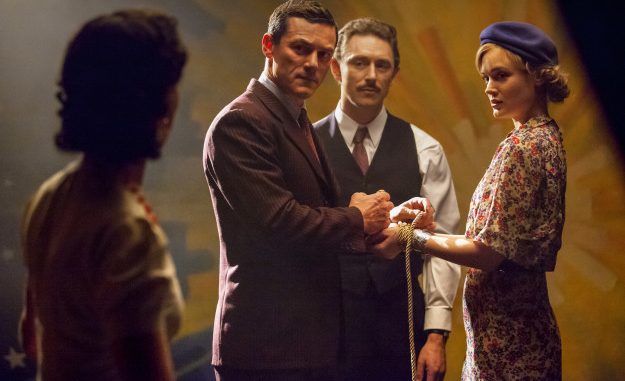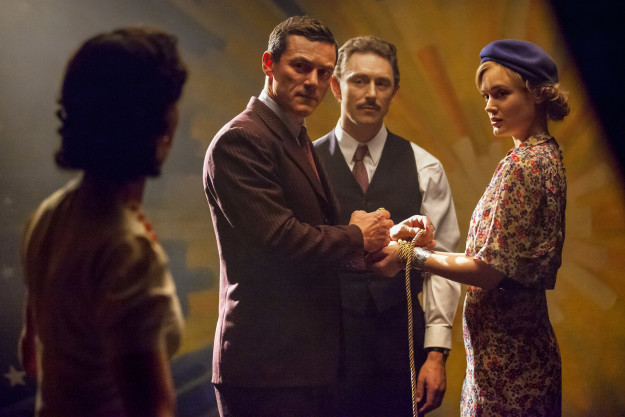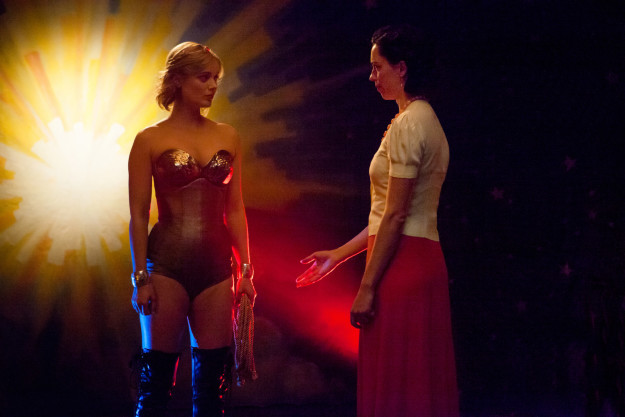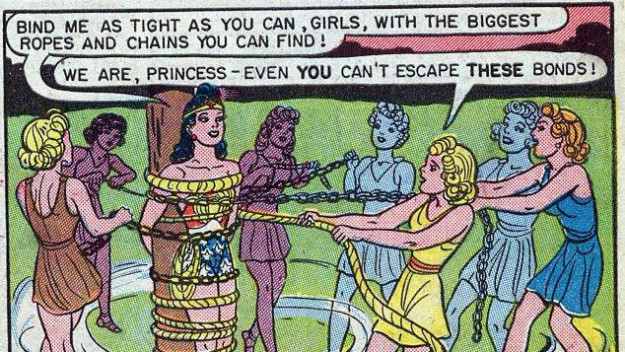

Elizabeth Marston (Rebecca Hall), Dr. William Marston (Luke Evans), Charles Guyette (JJ Feild), and Olive Byrne (Bella Heathcote) in Professor Marston and the Wonder Women.
Claire Folger / Annapurna Pictures
This summer, audiences flocked to theaters in record droves to see Gal Gadot slip on Wonder Woman’s kick-ass bracelets. But most of the millions who saw the Patty Jenkins movie probably don’t know much about William Moulton Marston, who created the DC Comics character. Marston’s story is often condensed to the fun fact that he also invented the lie detector test, but with Angela Robinson’s new movie Professor Marston and the Wonder Women, people are learning that the truly interesting thing about Marston lies in his relationship with the two women who assisted him, inspired him, and loved him — and each other — along the way.
At the start of the movie, William Moulton Marston (Luke Evans) and his wife, Elizabeth (Rebecca Hall), professors of psychology at Radcliffe College, become infatuated with their student Olive Byrne (Bella Heathcote). The Marstons are working on developing the lie detector and employ Olive to assist them, but with every test of their invention comes a new level of intimacy between the three of them. After finally establishing via a lie detector test that they all have feelings for one another, the trio shares a sweeping love scene backstage at the college’s theater, with Olive dressed in Grecian warrior garb, a hint at the origins of Diana of Themyscira.
While a threesome may be inherently titillating, Robinson and the cast of Professor Marston were sure to tread carefully in depicting the unorthodox romance. “I really wanted to capture what it felt like to fall in love, and to not otherize their experience at all,” Robinson, who wrote and directed the film, told BuzzFeed News at the Toronto International Film Festival in September. “I wanted to make it accessible, and I didn’t want to make it kinky or weird. I wanted to follow organically if three people fell in love with each other and really kind of track that.” Evans noted that he was very aware of the magnitude of getting the scene right. “In the wrong hands, those scenes specifically could have come across in the wrong way,” he said. “These weren’t three kinky, freaky people. These were three people that were in love.” Hall added that part of the appeal of joining the project was that “nobody tells stories of relationships that are not the norm” in a “positive, hopeful, wonderful, romantic, beautiful context.”

Olive and Elizabeth in Professor Marston and the Wonder Women.
Claire Folger / Annapurna Pictures
Hall said that in developing the scene in which William, Elizabeth, and Olive have sex for the first time, Robinson explained to her, “I want to shoot eroticism. I don’t want to shoot titillation. I’m trying to make the female-gaze version of this. What happens emotionally to these characters as they are finding out what is erotic to them, as they are discovering who they are sexually? What does that mean emotionally for them?”
To Hall, the most erotic scenes to shoot were the lie detector scenes. “It’s like extended foreplay. That’s where every character is saying, ‘Do you want to have sex with me? Do you want to have sex with me?’ And everyone has to answer honestly,” she explained. As Robinson said: “The lie detector scenes are about sex, and the sex scenes are about Wonder Woman.”
Shooting the actual sex scenes involved quite a bit of planning on Robinson’s part. She was focused on capturing the actors’ faces and the exchanging of consent through mere looks. “It’s about the intellectual and emotional consent per interaction that gives it its emotionality,” Robinson said. “I was very concerned with what they were thinking, which I ultimately found way sexier than what they were physically doing to each other.”

A sample from one of Marston’s Wonder Woman comics.
DC Comics
The director also wanted to make sure the actors felt comfortable, so she rested on a technique she used in her days directing episodes of The L Word and True Blood. “I allowed them to pick songs, and I’d play them really loud,” said Robinson. “I found that actors lose their self-consciousness and they can just perform with the music playing.”
The cast chose everything from Marvin Gaye, to “My Neck, My Back” by Khia, to Prince, to the White Stripes’ “Ball and Biscuit,” to Nina Simone. When Robinson finally called action on set — which consisted only of the three actors; the director of photography, Bryce Fortner; and one camera operator — Hall said Robinson started blaring “Let’s Get It On” out of loudspeakers. “We all burst into hysterical laughter. And that all set the tone for the rest of it,” the actor said. “We’re taking it seriously, but the same time, we’re having fun.” Heathcote also appreciated the gesture. “It’s great, because you laugh — for like a second, it takes you out of it. And then it’s just this background telling you to just have fun with it and relax.”
What also helped, according to Evans, was the vodka and Coke he and his castmates snuck into coffee cups to sip between takes. “Those scenes were much, much easier than I was expecting them to be — playing dress-up and being tied up, all that stuff is not everybody’s cup of tea,” Evans said. As the film shows Olive holding the Lasso of Truth and donning a very Wonder Woman–esque corset, how Marston’s sex life funneled into his work becomes glaringly clear.
Whether it was the music or the booze, in the end, Robinson thinks she and the cast achieved their goal of making the polyamorous BDSM sex scenes intimate, both emotionally and physically. “How they connected was very much part of their story and part of Marston’s theories,” she said. “So it wasn’t gratuitous in any way. It was essential.”
Reporting by Adam B. Vary.

